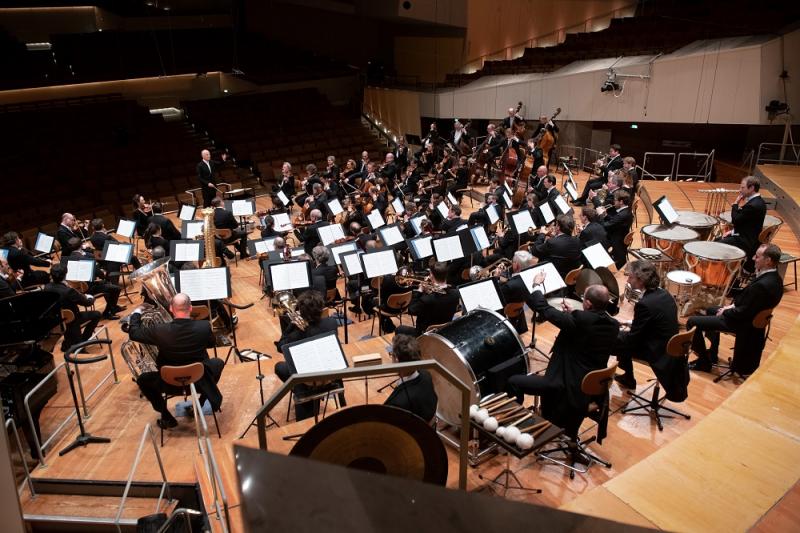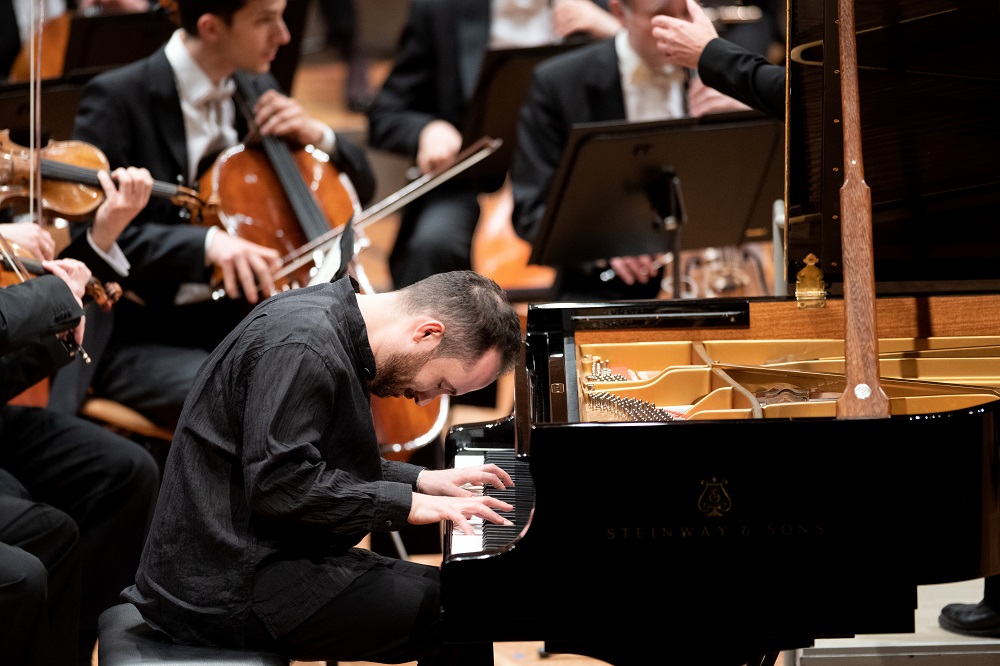Levit, Berlin Philharmoniker, Paavo Järvi, Digital Concert Hall review - optimal light and dark | reviews, news & interviews
Levit, Berlin Philharmoniker, Paavo Järvi, Digital Concert Hall review - optimal light and dark
Levit, Berlin Philharmoniker, Paavo Järvi, Digital Concert Hall review - optimal light and dark
Different energies in buoyant Beethoven and disturbing Prokofiev

It seems right that (arguably) the greatest orchestra in the world has (unarguably) the best livestreaming and archive service.
Bright comes before dark: this is a lithe, joyous Beethoven “Emperor” Concerto, only fitfully grandiose when the passing moment requires (as in the big rhythmic cannonades and octaves of the first-movement development). The orchestra under Järvi is as supple and winged as Levit (pictured below) in his solo passages, and this is that rare thing, a true concerto partnership. The pianist says in the splendid conversation with his conductor before the performance that he can actually take pleasure in what the orchestra’s doing while he ripples away arpeggio wise – the difficulty, he adds, being substantially less than comparable passages in Brahms’s First Concerto. You see it, to cite one of many instances, when the two horns (Stefan Dohr and Sarah Willis) float so artistically. It’s refreshing to have an Adagio which is genuinely un poco mosso. Each music lover will have his or her own idea of how this familiar music should go; some like it slower, but for me, this is the ideal.  What Järvi says, too, about Prokofiev in the interval is borne out by the shifting colours of a dark symphony to equal the monoliths of Shostakovich: always the element of surprise, of taking a turn you didn’t expect (a good pianist colleague of Levit’s, Boris Giltburg, made the same point about the composer’s elusiveness as compared to the more clear-cut progress of Shostakovich in my Russian music Zoom class last Thursday). The energy stops the tragic stretches ever being bogged down in self-pity; the Wagnerian drama of Prokofiev’s most astounding slow movement – it even quotes the “wound” motif from Parsifal, tying in with the composer’s own lost health after the Second World War – shines uncomfortably in that garish doubling of trumpet and first violins, but scales down to mellow, love-lorn horns and the toybox twinkle of harp and celesta.
What Järvi says, too, about Prokofiev in the interval is borne out by the shifting colours of a dark symphony to equal the monoliths of Shostakovich: always the element of surprise, of taking a turn you didn’t expect (a good pianist colleague of Levit’s, Boris Giltburg, made the same point about the composer’s elusiveness as compared to the more clear-cut progress of Shostakovich in my Russian music Zoom class last Thursday). The energy stops the tragic stretches ever being bogged down in self-pity; the Wagnerian drama of Prokofiev’s most astounding slow movement – it even quotes the “wound” motif from Parsifal, tying in with the composer’s own lost health after the Second World War – shines uncomfortably in that garish doubling of trumpet and first violins, but scales down to mellow, love-lorn horns and the toybox twinkle of harp and celesta.
The finale’s at first subtle underminings of a jolly pioneer galop accumulate with frightening speed towards the overpowering denouement. This is a work that ends on a chord of E flat major, but it’s the most devastating, surely, in any symphony. What a privilege to feel oneself back in the realm of the large-scale 20th century symphonic masterpieces again, though nothing will ever be as good as being there.
- Having gone out live, this performance is currently being edited for the permanent Digital Concert Hall archive (£)
- More classical music reviews from theartsdesk
rating
Share this article
The future of Arts Journalism
You can stop theartsdesk.com closing!
We urgently need financing to survive. Our fundraising drive has thus far raised £49,000 but we need to reach £100,000 or we will be forced to close. Please contribute here: https://gofund.me/c3f6033d
And if you can forward this information to anyone who might assist, we’d be grateful.

Subscribe to theartsdesk.com
Thank you for continuing to read our work on theartsdesk.com. For unlimited access to every article in its entirety, including our archive of more than 15,000 pieces, we're asking for £5 per month or £40 per year. We feel it's a very good deal, and hope you do too.
To take a subscription now simply click here.
And if you're looking for that extra gift for a friend or family member, why not treat them to a theartsdesk.com gift subscription?
more Classical music
 theartsdesk at the Lahti Sibelius Festival - early epics by the Finnish master in context
Finnish heroes meet their Austro-German counterparts in breathtaking interpretations
theartsdesk at the Lahti Sibelius Festival - early epics by the Finnish master in context
Finnish heroes meet their Austro-German counterparts in breathtaking interpretations
 Classical CDs: Sleigh rides, pancakes and cigars
Two big boxes, plus new music for brass and a pair of clarinet concertos
Classical CDs: Sleigh rides, pancakes and cigars
Two big boxes, plus new music for brass and a pair of clarinet concertos
 Waley-Cohen, Manchester Camerata, Pether, Whitworth Art Gallery, Manchester review - premiere of no ordinary violin concerto
Images of maternal care inspired by Hepworth and played in a gallery setting
Waley-Cohen, Manchester Camerata, Pether, Whitworth Art Gallery, Manchester review - premiere of no ordinary violin concerto
Images of maternal care inspired by Hepworth and played in a gallery setting
 BBC Proms: Barruk, Norwegian Chamber Orchestra, Kuusisto review - vague incantations, precise laments
First-half mix of Sámi songs and string things falters, but Shostakovich scours the soul
BBC Proms: Barruk, Norwegian Chamber Orchestra, Kuusisto review - vague incantations, precise laments
First-half mix of Sámi songs and string things falters, but Shostakovich scours the soul
 BBC Proms: Alexander’s Feast, Irish Baroque Orchestra, Whelan review - rapturous Handel fills the space
Pure joy, with a touch of introspection, from a great ensemble and three superb soloists
BBC Proms: Alexander’s Feast, Irish Baroque Orchestra, Whelan review - rapturous Handel fills the space
Pure joy, with a touch of introspection, from a great ensemble and three superb soloists
 BBC Proms: Moore, LSO, Bancroft review - the freshness of morning wind and brass
English concert band music...and an outlier
BBC Proms: Moore, LSO, Bancroft review - the freshness of morning wind and brass
English concert band music...and an outlier
 Willis-Sørensen, Ukrainian Freedom Orchestra, Wilson, Cadogan Hall review - romantic resilience
Passion, and polish, from Kyiv's musical warriors
Willis-Sørensen, Ukrainian Freedom Orchestra, Wilson, Cadogan Hall review - romantic resilience
Passion, and polish, from Kyiv's musical warriors
 BBC Proms: Faust, Gewandhausorchester Leipzig, Nelsons review - grace, then grandeur
A great fiddler lightens a dense orchestral palette
BBC Proms: Faust, Gewandhausorchester Leipzig, Nelsons review - grace, then grandeur
A great fiddler lightens a dense orchestral palette
 BBC Proms: Jansen, Royal Concertgebouw Orchestra, Mäkelä review - confirming a phenomenon
Second Prom of a great orchestra and chief conductor in waiting never puts a foot wrong
BBC Proms: Jansen, Royal Concertgebouw Orchestra, Mäkelä review - confirming a phenomenon
Second Prom of a great orchestra and chief conductor in waiting never puts a foot wrong
 BBC Proms: Royal Concertgebouw Orchestra, Mäkelä review - defiantly introverted Mahler 5 gives food for thought
Chief Conductor in Waiting has supple, nuanced chemistry with a great orchestra
BBC Proms: Royal Concertgebouw Orchestra, Mäkelä review - defiantly introverted Mahler 5 gives food for thought
Chief Conductor in Waiting has supple, nuanced chemistry with a great orchestra
 Dunedin Consort, Butt / D’Angelo, Muñoz, Edinburgh International Festival 2025 review - tedious Handel, directionless song recital
Ho-hum 'comic' cantata, and a song recital needing more than a beautiful voice
Dunedin Consort, Butt / D’Angelo, Muñoz, Edinburgh International Festival 2025 review - tedious Handel, directionless song recital
Ho-hum 'comic' cantata, and a song recital needing more than a beautiful voice
 Classical CDs: Dungeons, microtones and psychic distress
This year's big anniversary celebrated with a pair of boxes, plus clarinets, pianos and sacred music
Classical CDs: Dungeons, microtones and psychic distress
This year's big anniversary celebrated with a pair of boxes, plus clarinets, pianos and sacred music

Add comment